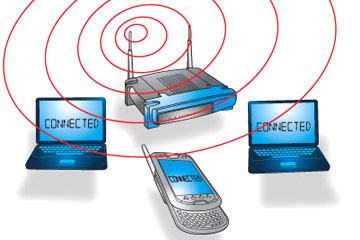Wireless Networking
Wireless Networking - 1
Chapter Objectives :-
- Compare Wireless and wired network
- Explain different wireless standards
- Components required for wireless networking
- Different types of wireless networking bands
- Setup a wireless network
- Troubleshoot wireless network problems
- Various applications of wireless networking
Introduction :-
Wireless technologies allow one or more devices to communicate with each other without any physical connections such as cables. Wireless technologies use radio frequency transmission for transmitting data. Using wireless network data can be transmitted between a wireless computer and a wired computer. Users need not disconnect their laptops, instead they can around the office and perform their tasks effectively. There are advantages of using wireless networks over wired networks like setting it up and freedom from cable connections.
(1) Wireless Networking Basics :-
Wireless networking allows you to establish a communication between two or more computers. The communication is established using radio frequency (RF) and without the use of cables. Wireless networking came in existence to provide connectivity between the wired network and mobile users. It would make your life more mobile and distance would no longer be a problem for interacting with the people. Wireless fidelity ( Wi-Fi ) and Home Radio Frequency ( HomeRF ) are the two wireless technologies based on IEEE 802.11. The basic wireless network is shown in the figure :
 |
| Basic Wireless Network |
In the above figure, laptops, computers and mobile phones are connected to each other through a wireless network. The devices can thus communicate with each other without the use of cables.
(1.1) Comparison Between Wired and Wireless Network :-
(1.1.1) Wired Network :-
- Wired Networking requires cables to be connected to each and every computer in the network. It becomes difficult to run cables through walls and under the floor making it time consuming.
- Low Noise signal.
- It offers better performance as compared to wireless networks. Wired network can offer 1000 Mbps bandwidth using Fast Ethernet technology. But, traditional Ethernet provides speeds up to 100 Mbps.
- Ethernet cables, switches, and hubs used in wired network are reliable. One of the problems that might occur in wired network is loose cable connection.
- It is more secured as compared to wireless network as the device are directly connected to switch.
- Existing wired network can be expanded by adding hubs and switches along with laying cables. So it is a tedious job to expand a wired network.
(1.1.2) Wireless Network :-
- Wireless Network can be configured in two ways: Ad hoc or infrastructure mode. Wireless device requires WLAN cards and access points for communication. So, installing a wireless network is quite simple as compared to wired networks.
- High noise signal
- Maximum bandwidth provided by wireless network is about 600Mbps. However , 802.11a and 802.11g provides speed upto 54 Mbps. Also the performance degrades if distance between the computer and access point increases or more device utilize the WLAN.
- Reliability of wireless network is less as compared to wired network. The main concern in wireless networks is interference from appliances using same frequency spectrum. However, with the proper installation the interference can be minimized.
- Is less secured as Hackers can access the wireless network from outside. Still, WLANs use Wi-Fi protected access ( WPA ) encryption to protect the data. This makes wireless networks as secured as wired networks.
- Mobility of wireless network is better as compared to wired network. Laptops and other mobile computing devices can be moved around freely within the wireless network range.
(1.2) Wireless Standards :-
Wireless technology work as per the standards accepted worldwide and offer different levels of security. The important aspects of wireless standards is that, the devices of different manufacturers should be able to operate with each other and no manufacturer will use his own standards for its device. The different wireless standards that are used in wireless networking are IEEE 802.11, Bluetooth, HomeRF, and IrDA.
(1.2.1) IEEE 802.11 :-
802.11 is a standard created by Institute of Electrical and Electronic Engineers (IEEE) for defining all aspects of Radio Frequency Wireless Networking. The wireless network technology uses the 802.11 standard deals with radio frequencies and data transmission 802.11 define the air interference between a wireless client and a base station or between two wireless clients. Base station is a two-way radio installation in a fixed location, used for communication with one or more wireless devices for example, Access point.
The two different spread spectrum methods defined by 802.11 are :
- Direct Sequence Spread Spectrum (DSSS)
- Frequency Hopping Spread Spectrum (FHSS)
The difference between These two are given in the table below :
 |
| Difference between DSSS and FHSS |
The most widely used adopted wireless networking type is Wireless Fidelity. i.e. Wi-Fi. The difference different standards certified by Wi-Fi are 802.11b, 802.11g and 802.11n. The wireless devices can communicate with each other only if they are using the same standard.
The different IEEE 802.11 standards used for wireless networking are shown in the table below :
 |
| IEEE 802.11 standards |
=================================================
Thanks for reading !
Have a good day !




Comments
Post a Comment